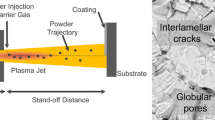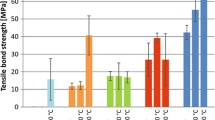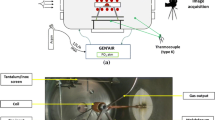Abstract
This paper deals with the mechanisms and kinetics of interactions between screen printed and fired PbO layers and ceramic substrates: alumina and beryllia. The interaction with alumina occurs via two main processes: (i) a reaction between PbO and Al2O3 grains, which induces the formation of a crystalline phase, Pb2Al2O5; and (ii) an interdiffusion process involving Pb and the intergranular amorphous phase in the ceramic substrate. This latter process results in a compositional change of the intergranular phase at considerable depths inside the ceramic substrate, as well as in the formation of a high lead glass layer on the substrate surface. Since PbO is not completely reacted, the Pb penetration in the ceramic is diffusion limited (penetration depth \(w \approx t_d^{1/2}\), where td is the reaction time) with an activation energy of 1.20 ± 0.05 eV. The ceramic microstructure significantly affects the interaction processes.
Similar content being viewed by others
References
R. D. Jones, Hybrid Circuit Design and Manufacture (Marcel Dekker, New York, 1982).
Thick Film Sensors, edited by M. Prudenziati (Elsevier, Amsterdam, 1994).
M. Prudenziati, B. Morten, and M. L. Brigatti, Active Passive Electr. Comp. 12, 41 (1985).
M. Prudenziati, B. Morten, F. Cilloni, G. Ruffi, and M. Sacchi, J. Appl. Phys. 65, 146 (1989).
C. Beraud, M. Courbiere, C. Esnouf, D. Juve, and D. Treheux, J. Mater. Sci. 24, 4545 (1989).
J. Murayama, H. Ikezaki, N. Taninuji, and T. Kato, Proc. Int. Symp. Microelectronics (ISHM, Reston, Vancouver, 1990), p. 303.
J. T. Klomp, Ceram. Bull. 51, 683 (1972).
S. V. Pepper, J. Appl. Phys. 47, 801 (1976).
F. S. Ohuchi, J. Am. Ceram. Soc. 74, 1163 (1991).
M. E. Twentyman, J. Mater. Sci. 10, 765 (1975).
D. M. Mattox and H. D. Smith, Ceram. Bull. 64, 1363 (1985).
S. S. Cole, Jr. and G. Sommer, J. Am. Ceram. Soc. 44, 265 (1961).
B. Morten, G. DeCicco, A. Gandolfi and C. Tonelli, Hybrid Circuits n.28, 25 (1992).
G. Liptay, Atlas of Thermoanalytical Curves (Heyden & Son, Ltd., London, 1971).
C. A. Sorrell, J. Am. Ceram. Soc. 55, 47 (1972).
R. W. G. Wyckoff, Crystal Structures (John Wiley & Sons, New York, 1968).
A. S. Grove, Physics and Technology of Semiconductor Devices (John Wiley, New York, 1967), Chap. 2.
Author information
Authors and Affiliations
Rights and permissions
About this article
Cite this article
Bersani, M., Morten, B., Prudenziati, M. et al. Interactions between lead oxide and ceramic substrates for thick film technology. Journal of Materials Research 12, 501–508 (1997). https://doi.org/10.1557/JMR.1997.0072
Received:
Accepted:
Published:
Issue Date:
DOI: https://doi.org/10.1557/JMR.1997.0072




